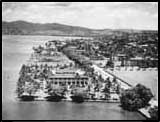 |
The Grand Pacific Hotel with the Boys' Grammar School in the distance (left), Queen Victoria Parade, Albert Park and Government Buildings (right). |
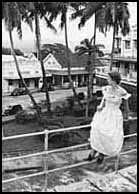 |
The Suva Triangle from the roof of the then Bank of New Zealand, 1950. The small oasis of The Triangle still stands in the centre of Suva, as it has since the capital was moved here in 1881. A plaque marks the spot of the first land auctions in Suva. The settlement involved the coerced removal of the indigenous people to the far less desirable area then called Suvavou, or "New Suva", beyond Lami. This settlement has spawned the notorious "sword-sellers" who harass tourists in Suva, a sort of belated revenge for their dispossession well over a century ago.* On the opposite side of Thomson Street as it becomes Victoria Parade can be seen the Union Steamship Co (left) and the GPO. Behind the model is Boots the Chemist, today Proud's Jewellers. The young woman in the photograph was an Australian, Maureen Duval, from Sydney's North Shore. She had won the trip to Fiji for winning the "Miss Neptune" competition sponsored by the Australian Women's Weekly. In this photo she was wearing a frock from Cole of America that was part of the wardrobe included in her prize. There is another picture of her with some local young women on the "People" site. She went on to have a long career as a high-profile media personality in Australia that was still going as recently as 2000. I am indebted to Bette Wright Jones for identifying Maureen Duval, and to my sister Beth Lucas for information about the Miss Neptune competition and Miss Duval's dress. *An excellent study of their plight is Miyazaki, Hirozaku: The method of hope. 2004, Stanford Uni Press. |
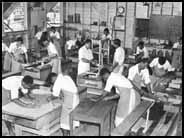 |
Nasinu Teachers' College (NTC), woodwork class |
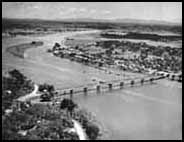 |
Na Wailevu, or Rewa River, with the bridge (reputedly constructed by the same engineers that built the Sydney coathanger), with Nausori township, the Colonial Sugar Refining Company sugarmill in the centre of the picture, and to the right CSR Hill, topped off with the house of the CSR (Fiji) General Manager - at the time of this photograph, Mr Clive ("Blue") Elliott. The hillock in the middle distance was the homestead hill for Manoca Estate, where I grew up, and behind that Lakena Estate. For a history of the CSR in Fji, see "South Pacific Enterprise", Sydney, Angus & Robertson, 1956. |
 |
The island kingdom of Bau |
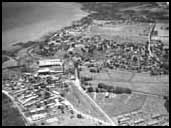 |
Lautoka CSR sugarmill, with CSR Hill centre right, and Lautoka township top left. Lautoka is Fiji's second largest town. |
 |
Wharf and township of Levuka, on the island of Ovalau.The first Europeans settled in Levuka in the early 1830s, and almost by default it became the first capital of Fiji. The Dufty photographs elsewhere on this website were all taken from his studio headquarters there. My grandfather arrived there in 1875, in the first year of Fiji being a British Crown Colony, and established a private school for the children of the settlers. This closed when the Levuka Public School was established in 1879, one of my great aunts being an assistant teacher in the new school, It was realised that the small island did not allow enough scope for expansion, and in 1881 Suva was established as the new capital. See Len Usher, 1987, "Mainly about Fji", Suva, Fiji Times. |
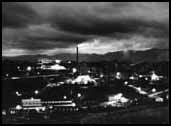 |
Vatukoula goldmine by night. The name of this place is an invention, composed of "vatu", meaning stone, and "koula", the Fijianised word for gold. Some gold was first discovered in this region in 1872, but in 1932 Bill Borthwick, an Australian prospector, discovered rich deposits. At the time of this photograph, the production of the Emperor and Loloma mines made gold Fiji's second highest money-earning export, behind sugar. See John Fraser, 1952, "Gold dish and kava bowl", London, J.M.Dent. |
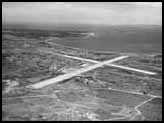 |
Developed as "Black Rock" as a military airfield in 1942, Nadi International Airport has been the main access point for visitors to Fiji since World War 2. At the time of this photograph the main aircraft flying international legs via Fiji were the Douglas DC6s of PAA (Pan American Airlines, later shortened to Pan American), TEAL (Tasman Empire Air Lines, later Air New Zealand) and BOAC (British Overseas Aircraft Corporation, the descendant of which is British Airways). In particular following the advent of wide-bodied jet aircraft in the late 1950s, the number of passengers, and pressure on Nadi Airport, increased exponentially. |
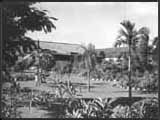 |
The Fiji Mocambo, built in response to the need for traveller accommodation near the International Airport, was one of the first international-standard hotels in Fiji. It is still operating today. |